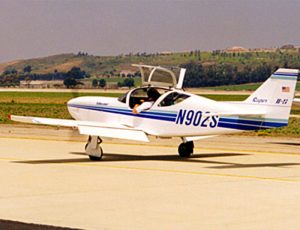 Our prototype II-S with the 32% larger horizontal stabilizer modified last fall has been undergoing more extensive rework to configure it representative of our existing Super II-S airframe kit. It now has also had the wing moved aft 1.5″ and the fuselage lengthened 6″ between the windshield and the firewall.
Our prototype II-S with the 32% larger horizontal stabilizer modified last fall has been undergoing more extensive rework to configure it representative of our existing Super II-S airframe kit. It now has also had the wing moved aft 1.5″ and the fuselage lengthened 6″ between the windshield and the firewall.
In October of 1992, prior to these latest modifications, an analysis and flight test series was completed to determine a new aft e.g. limit for II-S Glasairs with the larger horizontal stabilizer and elevators. The analysis determined and reviewed the stick fixed neutral stability point, the amount that it shifted before and after the tail was enlarged, the stick free maneuver point by stick force per G measurements taken at various speeds and various G loads, and subjective pilot evaluation at different aft e.g. positions. An exact stick free neutral stability point could not be measured due to the scattered readings taken with the very light stick forces in that flight condition. Long phugoid tests were made at the newly selected aft e.g. limit of 31.5% MAC in cruise and climb. In both conditions the aircraft stability was found to be acceptable, even more stable than the aircraft was when flown with the original small tail at 28.5% MAC, (the aft limit set for that configuration). We also flew the aircraft with lead in the nose to simulate the configuration we were about to retrofit to. Now that the aircraft was modified with the longer nose and the wing moved aft, we were anxious to fly it.
Being conservative on the first flight I loaded the aircraft with only 20 gallons in the main tank, 8 gallons in the header tank and myself at about 190 lb putting the aircraft at a 17% MAC condition with the forward limit set at 13.5% MAC. I first conducted a high speed taxi down the runway to determine the amount of elevator authority available. I could lift the nose at 45 to 50 mph indicated with full, (slotted) flaps applied. After confirming that there was enough elevator control to flair during a landing with full flaps, I was assured that a partial flap landing would be a piece of cake. After a normal takeoff and climb I proceeded to test the aircraft stick forces by progressively banking into steeper bank turns and pulling Gs. The stick forces were greater than any Glasair I had previously flown, but not too heavy.
The more that I flew it the better I liked it. When testing the long phugoid the aircraft proved to be very stable as expected at that e.g. position. I then proceeded to test the elevator authority during stall, first in a clean configuration and then in a landing configuration. Even during a stall with full flaps deployed, the stall occurred well before full elevator deflection was achieved at a nose high attitude.
On the second flight I loaded the aircraft with full fuel putting the aircraft at 16.75% MAC. Although in this configuration I could not easily push down the tail when sitting on it on the ground, in flight there was still very adequate elevator authority as was during the first flight.
Also the stick forces per G were not noticeably different than on the first flight. During my second flight, I could not resist trying some aerobatics to feel the stick forces and judge the aircraft sport characteristics. What I found was an absolute delight! The aircraft seemed to flow through the maneuvers with ease and smoothness without any tendency to over pull.
In a nut shell I feel we have a real winner that is not only easy and fun to fly but has tremendous utility by being able to carry about as much as you can fit into the baggage area without approaching the aft e.g. limit.
We have contacted Mike McCaslin (an independent engineer) to conduct more flight testing with the new configuration. We will publish a report on his findings in our next quarter newsletter.



